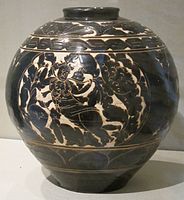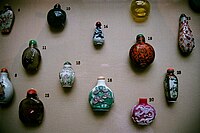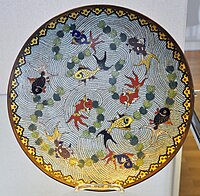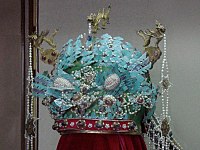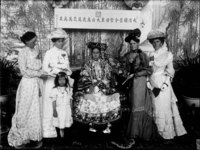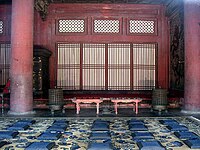User:Shenhaozhou/sandbox
This article may require copy editing for grammar and tone. (February 2013) |
Type of site | C2C and E-commerce |
|---|---|
| Available in | Chinese |
| Owner | Alibaba Group |
| URL | www.taobao.com |
| Commercial | Yes |
| Launched | May 2003 |
| Current status | active |
Taobao marketplace (simplified Chinese: 淘宝网; traditional Chinese: 淘寶網; pinyin: Táobǎo Wǎng) is a website for online shopping in Chinese language , similar to eBay and Amazon,[2] operated in the People's Republic of China by Alibaba Group.
Founded by Alibaba Group in May 10, 2003, Taobao marketplace facilitates consumer-to-consumer (C2C) retail by providing a platform for small businesses and individual entrepreneurs to open online retail stores that mainly cater to consumers in mainland China, Hong Kong, Macau and Taiwan.[3]
Of around 760 million product listings as of March 2013, Taobao marketplace is one of the world’s top 20 most visited websites according to Alexa. [4] For the year ended March 31, 2013, the combined gross merchandise volume (GMV) of Taobao Marketplace and Tmall.com exceeded 1 trillion yuan.[5]
Sellers are able to post new and used goods for sale or resale on the Taobao marketplace either through a fixed price or by auction. The overwhelming majority of the products on Taobao marketplace are brand new merchandise sold at a fixed price, while auctions merely make up a very small percentage of transactions. Buyers can assess seller backgrounds by information available on the site, including ratings, comments and complaints.
History[edit]
Taobao marketplace (formerly "Taobao") was launched in May 2003 by Alibaba Group after eBay acquired Eachnet, China’s online auction leader at the time, for USD 180 million and became the major player in the Chinese consumer e-commerce market at that time.[6] To counter eBay’s expansion, Taobao offered free listings to sellers and introduced website features designed to act in the best interests of local consumers, such as an instant messaging tool for facilitating buyer-seller communication and an escrow-based payment tool, Alipay. As a result, Taobao became the undisputed market leader in mainland China within two years. Its market share surged from 8% to 59% between 2003 and 2005, while eBay China's plunged from 79% to 36%.[7] Finally, eBay shut down its own site in China in 2006.
In April 2008, Taobao introduced a newly dedicated B2C platform called Taobao Mall to complement its C2C marketplace. Since then, Taobao Mall has established itself as the destination for quality, brand name goods for Chinese consumers. Taobao Mall launched an independent web domain, Tmall.com, and enhanced its focus on product verticals and improvements in shopping experience in November 2010. It became an independent business in June 2011 and changed its Chinese name to Tian Mao (Tmall) in January 2012. As of October 2013 it was the eighth most visited website in China. [8]
In 2008, Taobao fueled the overall growth of the Chinese online shopping industry, through execution of the “Big Taobao” strategy with the aim of becoming a provider of e-commerce infrastructure services for all e-commerce market participants.
In October 2010, Taobao beta launched eTao as an independent searching engine for online shopping, providing product and merchant information from a number of major consumer e-commerce websites in China. Online shoppers can use the site to compare prices from different sellers and identify products to buy. According to the Alibaba Group website, eTao offers products from Amazon China, Dangdang, Gome, Yihaodian, Nike China and Vancl, as well as Taobao and Tmall. [9]
In May 2011, Alibaba Group opened a physical furniture store in Beijing under the Taobao Mall trademark. The five-story 25,000sqm Taobao Mall iFengChao Furniture Showroom[10] opened as a complement to their online stores.
In June 2011, Alibaba Group Executive Chairman and former CEO Jack Ma announced that Taobao would be split into three different companies: Taobao Marketplace (a C2C platform), Tmall.com (a B2C platform; then called Taobao Mall), and eTao (a search engine for online shopping ). The move was said to be necessary for Taobao to “meet competitive threats that emerged in the past two years during which the Internet and e-commerce landscape has changed dramatically.”[11]
From 2012 onwards, Taobao began to accept international Visa and MasterCard credit cards;[12] prior, only domestic banks were supported by AliPay. The plan to support international credit cards was announced in late 2011.[13]
On April 29, 2013,Alibaba announced an investment of USD 586 million in Sina Weibo. According to Reuters, the deal “should drive more web traffic to Alibaba's Taobao marketplace, China's largest e-commerce website with a consumer focus.”[14] On August 1, 2013, Alibaba launched Weibo for Taobao, which allows users to link Sina Weibo accounts with Taobao accounts.[15]
Services & Features[edit]
Tmall.com[edit]
Tmall.com offers a shopping experience for increasingly affluent Chinese consumers that offers them the opportunity to buy Western brands. According to the Alibaba Group website, these brands include UNIQLO, L’Oréal, Adidas, P&G, Unilever, Gap, Ray-Ban, Nike and Levi's.[16] ). Again, according to the Alibaba Group site, Tmall.com and Taobao marketplace set a record for highest single-day transaction volume during a special promotion on November 11, 2012, facilitating sales of goods totaling RMB19.1 billion on the day. For the year ended March 31, 2013, the combined gross merchandise volume (GMV) of the two platforms exceeded RMB1 trillion.[17]
Mascot[edit]
Taobao’s mascot is the ant, representing their corporate culture as well. "We are the ant army." Jack Ma has introduced Taobao to the outside world. He has used the word "ant army" on more than one occasion. It can be remembered that Jack Ma once organized more than 2,000 employees at a gymnasium collectively at Alibaba to celebrate the 5th anniversary of the founding ceremony. At the party,Taobao employees waved the Taobao mascot — the flag of "ants." At the end of the celebration that lasted for four hours, all the employees stood hand-in-hand, singing "If you do not experience wind and rain, you cannot see the rainbow. Ants that be organized together can beat the elephant."
How to read the shop feedback Taobao?[edit]
To thoroughly investigate a Taobao shop, a good way is to view its feedback by clicking the shop's rating icon. For Tmall.com shops, people click the stars to view their ratings. Taobao netizens usually spend time to read feedback and compare items of one shop with those of others.[18]
Ways to avoid fraud on Taobao[edit]
- Verify the authenticity of the seller’s credibility.
- Specifically check the sellers’ evaluations.
- Be very clear on the details of the goods you are going to purchase before you decide to buy.
- Watch out for goods that are sold at fire sale prices.
- Do not remit money to sellers' bank card accounts.
- Make terms of payment clear with the sellers.
- Do not promise to trade face to face.
- Chat in depth with the seller before making your purchase.
Alipay[edit]
Launched in 2004, Alipay (www.alipay.com) (simplified Chinese: 支付宝; traditional Chinese: 支付寶; pinyin: Zhīfùbǎo), an escrow-based online payment platform, is the preferred payment solution for transactions on Taobao marketplace. It is the most widely used third-party online payment solution in China.[19] To ensure safe transactions, Alipay uses and escrow system through which payment is only released to the seller when the buyer has received his or her goods in satisfactory condition.
According to the Alibaba Group website, Alipay partners with multiple financial institutions as well as Visa and Mastercard to facilitate payments in China and abroad.[20]
AliWangWang (TradeManager)[edit]
A distinctive feature of shopping on Taobao marketplace is the pervasive communication between buyer and seller prior to the purchase through its embedded proprietary instant chat program, named AliWangWang (Chinese: 阿里旺旺; pinyin: ĀlǐWàngWàng). It has become a habit among Chinese online shoppers to “chat” with the sellers or their customer service team through AliWangWang to inquire about products, engage in bargaining, etc., prior to purchasing products.
Happy Taobao[edit]
In Dec. 2009, Taobao together with Hunan TV set up Happy Taobao, Inc for television shopping. Not only did Hunan TV launch an entertainment called "Happy Taobao", Taobao Marketplace also created channels and independent websites, both of which were to combine electronic commercial with TV media.
Others[edit]
Taobao marketplace has introduced various new features and services in recent years to create a more holistic user experience for online shoppers and retailers. For instance, in January 2010, it launched the Taobao application created by independent developers through the Taobao Open Platform, to be downloaded by consumers in App Store ;[21] in March 2010, it introduced the Taobao Data Cube platform, which gives small businesses access to its aggregate consumer transactions data for insight into key industry trends;[22] and in June 2010, it partnered with Wasu Media Internet Limited to launch a digital entertainment products platform Taohua and interactive digital television shopping, which are operated by a joint-venture formed by the two companies.[23]
Metrics[edit]
Taobao marketplace has more than 500 million registered users as June of 2012 and currently hosts more than 800 million product listings.[24] It has facilitated approximately RMB200 billion in gross merchandise volume in 2009.[25] In September 2013, Taobao ranked 12th overall in Alexa's internet rankings.[26]
Financials[edit]
For the year ending March 31, 2013, the combined gross merchandise volume (GMV) of Taobao and Tmall.com combined exceeded RMB1 trillion.[27]
References[edit]
- ^ "Taobao.com Site Info". Alexa Internet. Retrieved 2013-10-01.
- ^ "淘宝网=eBay+乐天+亚马逊 (Taobao=eBay+Rakuten+Amazon)" (in Chinese). 国际金融报. 9 Jul 2009. Retrieved 14 May 2011.
- ^ "Taobao.com launches online shopping mall". china.org.cn. 2008-01-15. Retrieved 2010-09-09.
- ^ "Alexa.com Taobao Statistics". Alexa.com. Alexa.com. Retrieved 21 October 2013.
- ^ "Alibaba Group Company Overview". Alibaba Group. Alibaba Group. Retrieved 21 October 2013.
- ^ ""eBay China Rumors". Search Engine Journal. September 26, 2006".
- ^ ""China's pied piper". The Economist. September 21, 2006". The Economist. September 21, 2006.
- ^ "Alexa.com Tmall.com Access Statistics". Alexa.com. Alexa.com. Retrieved 21 October 2013.
- ^ "Alibaba Group Company Overview". Alibaba Group. Alibaba Group. Retrieved 21 October 2013.
- ^ Taobao Field Guide. May 31, 2011.
- ^ Bloomberg. June 16, 2011.
- ^ 淘宝全面接受海外信用卡付款, Taobao.com
- ^ 2011-10-19, 支付宝将向全球开放 国外用户可购物淘宝, Phoenix TV Finance
- ^ "Alibaba pushes into social networking with Weibo investment". Reuters. Reuters. Retrieved 21 October 2013.
- ^ Alibaba Released Weibo for Taobao with Sina China Internet Watch,August 5, 2013
- ^ "Alibaba Group Company Overview". Alibaba Group. Alibaba Group. Retrieved 21 October 2013.
- ^ "Alibaba Group Company Overview". Alibaba Group. Alibaba Group. Retrieved 21 October 2013.
- ^ "How to read taobao shop feedbacks?". NewBuyBay Taobao Agent. January 13, 2013".
- ^ "Alibaba is building its Alipay payments service into the PayPal of the East". The Next Web. The Next Web. Retrieved 21 October 2013.
- ^ "Alibaba Group Company Overview". Alibaba Group. Alibaba Group. Retrieved 21 October 2013.
- ^ ""Taobao Launches New Taobao App Store". Alibaba Group. January 15, 2010".
- ^ "Taobao to Help Small Businesses Grow More Effectively". Alibaba Group. March 31 2010".
- ^ ""Taobao and Wasu Media Launch Digital Entertainment Products Platform, Digital Television Shopping to Broaden Consumer Choice". Alibaba Group. June 29, 2010".
- ^ Alibaba Group Company Overview
- ^ "Alibaba Group Company Overview". Retrieved 8 May 2012.
- ^ Alexa.com Taobao.com Site Info
- ^ http://cmuscm.blogspot.ca/2013/09/alibaba-chinese-style-ariba.html
External links[edit]
- official website (in Chinese)
Category:Alibaba Group Category:Online auction websites Category:Internet properties established in 2003 Category:Internet companies of China Category:Retail companies of China Category:Chinese websites Category:Online retail companies of China Category:2003 establishments in China
This article may require copy editing for grammar, style, cohesion, tone, or spelling. |

Chinese fine art was traditionally made for imperial purposes, and has a long history in China. This is in comparison to Chinese folk art.
Calligraphy[edit]
The Chinese imperial court collects the most valuable calligraphy pieces. They are done by the most talented calligraphers of each century. Every emperor, as an enthusiastic collector carried on their ancestors' tradition of adding their own seal mark on to the calligraphy pieces. These traditions made all of the pieces extremely valuable and collectible.[citation needed]
-
Crossing the Frozen River, a poem in running script by Kangxi Emperor (1654—1722), Palace Museum, Beijing
-
Calligraphy on fan by Mo Shilong, China, Ming dynasty, 16th century, ink on gold paper, Honolulu Academy of Arts
Ceramics[edit]
Chinese ceramics, which began in the pre-dynastic periods, has continuously improved since then. it is one of the most significant forms of Chinese art.
-
Dish with underglazed blue and overglazed red design of clouds and dragons, Jingdezhen ware, Yongzheng reign 1723-1735, Qing, Shanghai Museum
-
Sancai glazed ceramic horse, Tang Dynasty of China, 7th-8th Century, Musée Guimet
-
Chinese glazed stoneware jar, Yuan Dynasty, Honolulu Academy of Arts
-
blue glazed vase with golden medallion design, Jingdezhen ware,1875~1908 A.D., a collection of Shanghai Museum
Snuff bottle[edit]
When opium was introduced to China, snuff bottles then became popular. The Chinese royalties were addicted to it as well, and they used it as a long-life medicine. The design of the snuff bottles flourished because the money that was poured into the industry was by the rich. Many snuff bottles were made by talented artisans, using tiny paint brushes, and painted from inside of the bottle reaching down from the top of narrow neck. They are highly collectible still to this day.[citation needed]
-
Chinese snuff bottles, various time periods, British Museum in London.
-
Chinese snuff bottle, 19th century, glass bottle with jadeite stopper, Honolulu Museum of Art
Cloisonné[edit]
-
Large gilded copper plate with cloisonné, Qing Dynasty, 19th century, Museum für Angewandte Kunst, Frankfurt
-
Pilgrim flask decorated with peaches and pomegrenates; Ming Dynasty, 1st half of 17th century, Museum Rietberg, Zurich
-
Qilin-shaped incense burner (17th-18th centuries) on display at the Iris & B. Gerald Cantor Center for Visual Arts on the Stanford University campus in Stanford, California.
Engraving[edit]
-
A golden canteen made during the Chinese Ming Dynasty, dated 15th century, Freer and Sackler Galleries, Washington D.C.
-
A Chinese red lacquer tray over wood with engraved golden foil, from the Song Dynasty (960–1279 AD), dated 12th to early 13th century. Freer and Sackler Galleries, Washington D.C.
Jewellery[edit]
-
Hair pin, Art collection in the Palace Museum, Beijing
-
Hair Ornament, 19th century, Walters Art Museum
-
Ceremonial Headdress, 19th century, Walters Art Museum
-
Chinese Imperial Queen's Headdress, Ming Dynasty, Mings Tomb Museum
Lacquer[edit]
During the Shang Dynasty (ca. 1600–1046 BCE), the sophisticated techniques used in the lacquer process were first developed and it became a highly artistic craft,[1] various prehistoric lacquerware have been unearthed in China dating back to the Neolithic period.[1] The earliest extant lacquer object, a red wooden bowl,[2] was unearthed at a Hemudu culture (ca. 5000-4500 BCE) site in China.[3] By the Han Dynasty (206 BCE – 220 CE), many centers of lacquer production became firmly established.[1] The knowledge of the Chinese methods of the lacquer process spread from China during the Han, Tang and Song dynasties. But, eventually it was introduced to Korea, Japan, Southeast and South Asia.[4]
-
Chinese Mother of Pearl Lacquer Box with Peony Decor, Ming Dynasty, 16th Century, Museum für Lackkunst, Münster (Germany)
-
A detail of "Prosperity in an imperial palace", a 12 panel screen of lacquered wood (1670) on display at the Asian Art Museum in San Francisco, California.
Painting[edit]
-
‘Pink and White Lotus’, hanging scroll, 14th century China, Kimbell Art Museum
-
Chen Cheng-po, 1933, canvas oil painting, Collection of Taiwan Museum of Fine Art
-
Wood, Bamboo, and Elegant Stone, Ni Zan, 1360s-1370s, Palace Museum
Photography[edit]
Photography was used in several China's cities soon after the invention of photography in 1839 and the arrival of European photographers in Macao. At first, people who were superstitious, thought having the camera and take a picture of them would result in their spirit being taken away. By the end of the nineteenth century, all major cities had photographic studios. Some affluent Chinese people adopted photography as a hobby. Western and Chinese photographers documented ordinary street life, major wars, and prominent figures.[citation needed]
-
The Cixi Imperial Dowager Empess of China
-
Three-year-old Emperor of China Pu Yi, February 23, 1909, Library of Congress
The Empress Dowager Cixi had her portrait taken repeatedly.
Sculpture and carving[edit]
The 18th Century Qing dynasty covered vase depicts a woman who is holding lingzhi fungus and a peony branch. See is accompanied by a boy, crane, and a deer.[citation needed]
-
Covered Vase Decorated with Female Figure, Qing dynasty, 18th century, coral, Asian collection in the Worcester Art Museum, Worcester, Massachusetts
Ivory Carving[edit]
Ivory was not a prestigious material in the rather strict hierarchy of Chinese art, where jade has always been far more highly regarded, and rhinoceros horn, which is not ivory, had a special auspicious position.[5] But ivory, as well as bone, has been used for various items since early times, when China still had its own species of elephant — demand for ivory seems to have played a large part in their extinction, which came before 100 BC. From the Ming Dynasty ivory began to be used for small statuettes of the gods and others (see gallery). In the Qing Dynasty it suited the growing taste for intricate carving, and became more prominent, being used for brush-holders, boxes, handles and similar pieces, and later Canton developed large models of houses and other large and showy pieces, which remain popular.[6] Enormous examples are still seen as decorative centrepieces at government receptions. Figures were typically uncoloured, or just with certain features coloured in ink, often just black, but sometimes a few other colours.[citation needed]
-
Ivory figurine of Wen Chang, the "God of Literature". Circa 1550-1644, Ming dynasty, Royal Ontario Museum.
-
A pair of ivory fans depicting scenes from Romance of the Western Chamber, approx. 1800-1911, Qing Dynasty. On display at the Asian Art Museum in San Francisco, California.
-
A Chinese ivory table screen with carved decoration of an outdoor scene, from the Qing Dynasty, dated to the reign of the Qianlong Emperor (1735–1796).
Governmental seals[edit]
Seal sculpture (紐刻), is an art that originated in ancient China and is mainly popular in East Asian countries. It focuses or decorates on the head-part or the top-side of a seal. It is a kind of sculpture or mini-sculpture. In China, the utmost important seal of all is the imperial seal called 'He Shi Bi', now lost, it was said that the green jade took a form of a round shape with inscriptions read "Having received the Mandate from Heaven, may (the emperor) lead a long and prosperous life." (受命於天,既壽永昌) written by the Primer Li Si for Qin Shi Huang Zhao zheng, the Augustus Emperor of The Chinese Empire.[citation needed]
Ruyi[edit]
Ruyi is a scepter that serves primarily as a decoration. Its history began in the Qing Dynasty when the Ruyi sceptors given to noted visitors of the emperor. Now they're given as birthday presents. It is made of different materials, including porcelain and jade. The term Ruyi means "may your wish be granted" or "as you wish". The unusual shape is meant to imitate the shape of a stemmed lotus flower.[7]
-
A gold ruyi carved with flowers. Qing Dynasty (1644-1911). Palace Museum, Beijing.
-
Ornament with persimmon, lily & ruyi fugngus, chalcedony, 1900–49, Qing Dynasty or Republic Period. On display at the Asian Art Museum of San Francisco.
Stone carving[edit]
Woodwork[edit]
-
Chinese bamboo carving, Qing Dynasty, c.1900
-
Portable Buddhist Shrine, 10th century, carved wood, Walters Art Museum
Textile arts[edit]
Embroidery[edit]
Chinese embroidery is some of the oldest extant needlework. The four major regional styles of Chinese embroidery are Suzhou (Su Xiu), Hunan (Xiang Xiu), Guangdong (Yue Xiu) and Sichuan (Shu Xiu). All of them are nominated as Chinese Intangible Cultural Heritage.[citation needed]
-
Embroidered silk, 1770-1820, Qing Dynasty
-
Golden pheasant rank badge, 2nd rank civil servant, silk tapestry with painted details. China, Qing Dynasty, late 18th – early 19th century. Denver Art Museum
-
Detail of qifu (imperial dragon robe), late 19th or early 20th century, silk, gilt thread, twill and damask weave, embroidery, Honolulu Academy of Arts
-
Detail of the central embroidery work of a woman's summer robe, silk gauze, approx. 1875-1900, Qing Dynasty. On display at the Asian Art Museum of San Francisco.
-
Chinese summer court robe ("dragon robe"), c. 1890s, silk gauze couched in gold thread, East-West Center
Rugs[edit]
-
A room with traditional Chinese wedding decorations and rugs, Forbidden City in Beijing
-
A room with blue patterned carpet and hanging dragon rug, Forbidden City, Beijing
Woven material[edit]
-
Detail of qifu (imperial dragon robe), late 19th or early 20th century, silk, gilt thread, twill and damask weave, embroidery, Honolulu Academy of Arts
See also[edit]
|
Wikimedia Commons has media related to Art of China.
|
References[edit]
Bibliography[edit]
- Chang, Zonglin. Li, Xukui. (2006). Aspect of Chinese culture. 中国文化导读. 清华大学出版社 publishing
- Institute of the History of Natural Sciences and Chinese Academy of Sciences, ed. (1983). Ancient China's technology and science. Beijing: Foreign Languages Press. ISBN 978-0-8351-1001-3.
- Rawson, Jessica (ed). (2007). The British Museum Book of Chinese Art, (2nd edn). British Museum Press. ISBN 978-0-7141-2446-9
- Stark, Miriam T. (2005). Archaeology of Asia. Malden, MA : Blackwell Pub. ISBN 1-4051-0213-6.
- Wang, Zhongshu. (1982). Han Civilization. Translated by K.C. Chang and Collaborators. New Haven and London: Yale University Press. ISBN 0-300-02723-0.
- Webb, Marianne (2000). Lacquer: Technology and conservation. Oxford: Butterworth-Heinemann. ISBN 978-0-7506-4412-9.









